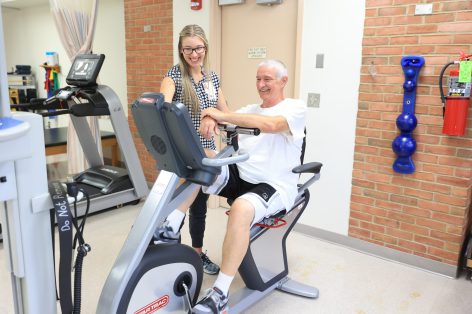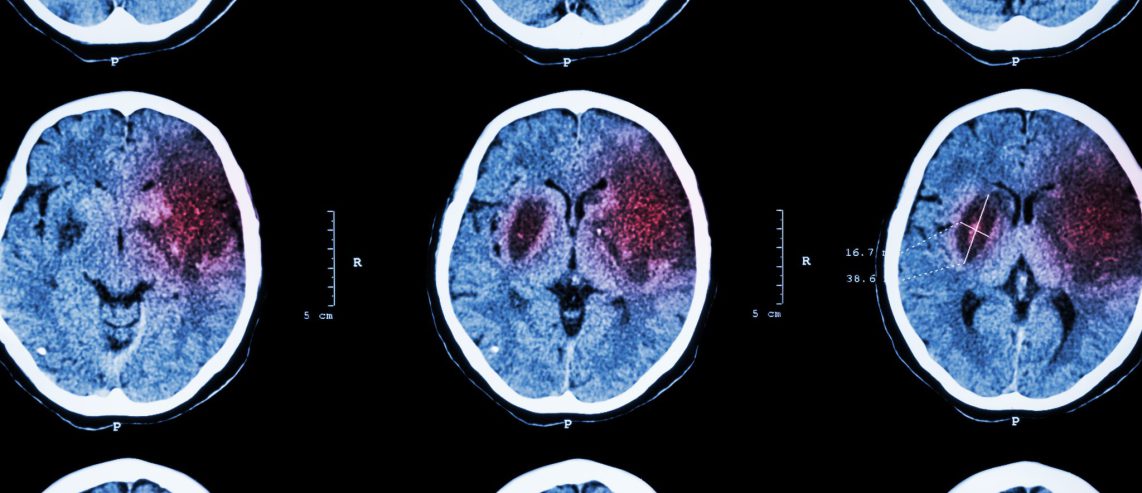It was just a regular day in January 2022 for 60-year-old Charles (Chuck) D. of Williamsport, Pa. He was running errands and putting things away. A short time later, his wife found him unconscious on the floor near his computer.
Chuck had experienced an ischemic stroke.
“I came to, but I couldn’t move,” says Chuck. “My wife called 911. That’s how this nightmare started.”
What Is an Ischemic Stroke?
An ischemic stroke occurs when a blood vessel in the brain becomes blocked, and blood flow stops. The blockage may result from a blood clot.
The clot travels to the brain and blocks blood and oxygen so that part of the brain dies. This type of blockage accounts for about 87% of all strokes.
Stroke is the leading cause of adult disability and the fifth leading cause of death in the United States.

Never Miss a Beat!
Subscribe to Our HealthBeat Newsletter!
Thank you for subscribing!
You can now select the specific newsletters you'd like to receive.
You are already subscribed.
Subscribe to more newsletters in our email preference center.
Sorry, an error occurred. Please try again later.
Get Healthy Tips Sent to Your Phone!
What Causes an Ischemic Stroke?
Ischemic strokes have many causes, including:
- Blood clotting disorder (hypercoagulability).
- Hardening of the arteries (atherosclerosis).
- Heart attack (myocardial infarction).
- Infection (inflammation of brain arteries).
- Irregular heartbeat (atrial fibrillation).
- Narrowing of one of the main arteries in the neck (carotid artery disease).
- Small vessel disease (lacunar infarction).
- Small hole in the heart chamber wall (atrial septal defect).
A stroke can lead to:
- Death.
- Lasting brain damage.
- Long-term disability.
“In Chuck’s case, the stroke affected the area of his brain that controls his right arm, right leg, and some of his speech,” says Christopher Benfield, PT, manager of therapy operations, UPMC Outpatient Center (Cree Dr.) in Lock Haven.
“Following a stroke, the brain needs to find new pathways to use or strengthen the existing neural and muscular structure to support the parts of the brain that have been damaged.”
Chuck’s Stroke Rehabilitation Begins
In March 2022, following some at-home physical therapy, Chuck arrived at UPMC Outpatient Center (Cree Dr.) in Lock Haven.
“When we first met Chuck, he was in a wheelchair. His son had to push him,” says Chris. “He needed physical help to stand up from the chair and could only walk very short distances with a quad cane. His right arm did not function at all.”
“When I started with the therapy, I couldn’t really do much,” says Chuck. “It was like starting from scratch, but they helped to lift me out of the funk I was in, and we just got started.”
Chuck Makes Progress
Since Chuck started therapy roughly 15 months and 116 therapy sessions ago, he has never given up. He continues to make strides large and small.
In stroke recovery, making significant progress and then hitting a plateau is a common outcome. When patients plateau, progress is noticeably slower.
As a result, this is often when patients become frustrated and give up on therapy. They think they’ve improved as much as they ever will. They decide that however far they’ve come is good enough.
“The thing about Chuck is he is not satisfied with ‘good enough,'” says Chris. “He’s not going to be satisfied until he functions as well as he possibly can. Nearly every session, he brings up something that he’s struggling with and asks for exercises to get better at that task.”
When Chuck first started therapy, his right arm hung flaccidly at his side. Eventually, he was able to bend the arm 90 degrees. Now he can lift 20 pounds.
Today, Chuck also walks on his own without a device, dresses and cares for himself, goes swimming, and drives a car. He can spend time doing the things he enjoys with his family again.
UPMC Outpatient Center (Cree Dr.) in Lock Haven: Comprehensive Rehabilitation Care Under One Roof
UPMC Outpatient Center (Cree Dr.) is the only UPMC site in Clinton County that offers occupational therapy, physical therapy, and speech therapy. Chuck has benefited from each of these specialties over the past 15 months.
“Chuck has hung in there for so long through the months when he made only minute improvements and works very hard at whatever we ask him to do in therapy and on his own outside of therapy,” says Chris.
Chuck says he’s so grateful for Chris and all the help and support he’s gotten from other specialists at Lock Haven, including McKenzie Hakin, COTA/L, occupational therapy assistant; Melody Henderson, OTR/L, occupational therapist; and Nicole Kaizen, SLP, speech language pathologist.
Here for Chuck
UPMC has provided care for Chuck from the start — from immediately after his stroke when he transferred to UPMC Williamsport to inpatient rehabilitation at UPMC Rehabilitation Institute in Williamsport to outpatient rehabilitation at UPMC Outpatient Center (Cree Dr.) in Lock Haven.
Throughout his journey, UPMC has provided a continuity of care that has helped Chuck stay consistent in his treatment and his progress. He has found comfort in knowing that UPMC is there for him even when his needs change.
“I get so emotional about everything I’ve been through,” says Chuck. “I’m a heck of a lot better because of the therapists. They don’t let me give up, and they never give up on me. I’m so glad they’re here. I just want to keep getting better.”
Sources
About UPMC
Headquartered in Pittsburgh, UPMC is a world-renowned health care provider and insurer. We operate 40 hospitals and 800 doctors’ offices and outpatient centers, with locations throughout Pennsylvania, Maryland, New York, West Virginia, and internationally. We employ 4,900 physicians, and we are leaders in clinical care, groundbreaking research, and treatment breakthroughs. U.S. News & World Report consistently ranks UPMC Presbyterian Shadyside as one of the nation’s best hospitals in many specialties and ranks UPMC Children’s Hospital of Pittsburgh on its Honor Roll of America’s Best Children’s Hospitals. We are dedicated to providing Life Changing Medicine to our communities.
